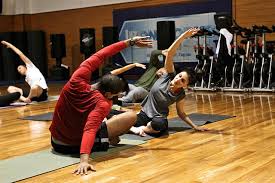It’s not easy to know how to stretch properly
How to stretch is important. However, for the vast majority of us in modern day society, we tend to fluctuate between extremes. Our working days are often sedentary. Our time is spent sitting in front of a computer with little or no need to move or exercise unless it is for a lavatory break or for a coffee run.
Then for a small pocket of time, we want to exercise like crazy. We push ourselves hard in the gym to experience the adrenaline rush and relieve some of the pent-up frustration. But often we forget to transition. We forget to go through the gears from sedate to manically active.
We know we should warm up and stretch. But how should we do it? How can we be sure we are getting it right?

What not to do when stretching
The topic of stretching is almost as complicated, confusing and as controversial as the topic of food and nutrition. Experts rarely agree whole-heartedly on the nuances and protocol of this activity, in the same way that dieticians rarely agree on exactly what you should eat.
However, in both fields, there are some areas in which there is widespread agreement as to what should be off the menu. For that reason, it is easiest to start with stretching pitfalls you should definitely avoid.
Most experts agree that ballistic stretching is bad for you. And even though it is a little ‘old school’ there are still plenty of people that still do it. It involves taking a stretch to the edge of its range and then using a bouncing motion to attempt to increase it. There are no upsides to this, and involves a high risk of injury.
The next pitfall is stretching before you have warmed the body’s core body temperature. It is not a warm-up! It can be part of a warm-up process, but you literally need to raise your body temperature by one or two degrees Celsius (1.4 to 2.8 degrees Fahrenheit) before you start them. The connective tissue will be far less receptive to being stretched when cool.
You also need to avoid restricted stretching. Most people stick to the one or two they know (often learned at school) such as calf, quad, and hamstring stretches.
Stretches are important because they prepare the body for any movements that follow. They also help restore movement in tired and worked muscles.
There are many areas that you may not be stretching that are involved in most sports and exercise. These include the IT band, the hip-flexors, the glutes and the quadratus lumborum.
What type of stretches to include
Once you are confident that your stretches are safe and that your stretching covers all the important areas of the body, the next decision concerns whether you should do static or dynamic stretching.
Static is the most traditional. It involves holding a stretch in a certain position.
Dynamic is a movement that allows the muscles to gently stretch as part of that movement.
The benefits and drawbacks of the two types are a cause for debate.
It is worth finding a specialist who can explain them to you and show you some simple versions. They won’t take long to learn, and will improve your mobility.
We hope this information is useful for you. If you need advice or have any questions about our treatments, please contact us. You can find us in Mill Hill Broadway and Islington. We are always happy to help!
If you like this blog, please share it!



